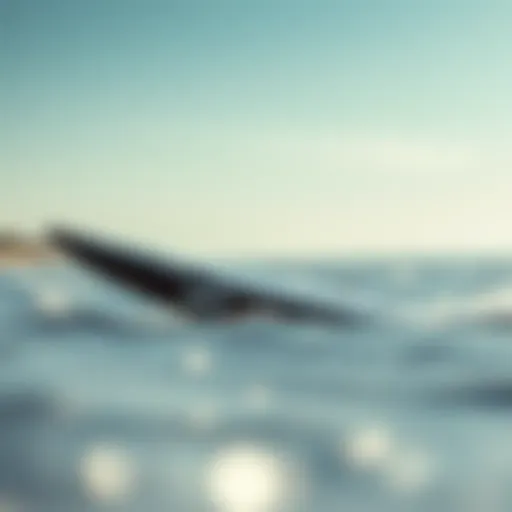Kite Gear Essentials: A Buyer’s Guide
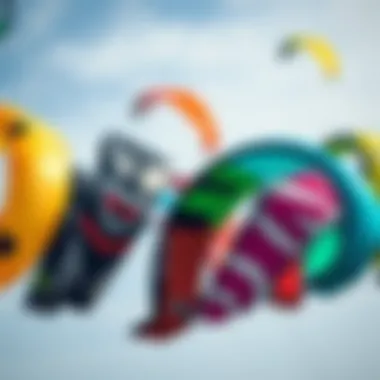

Intro
Diving into the exhilarating world of kiteboarding is a venture ripe with excitement, yet it can also feel like navigating a maze without a map. With a plethora of kite gear available for sale, it becomes crucial to discern which products truly enhance your experience and meet your individual needs. The variety can be bewildering, but understanding the essential components and their features sets the stage for a rewarding adventure on the water.
Whether you're just dipping your toes into the sport or you're a seasoned pro, knowing what to look for can save you time and, more importantly, money. Gear selection impacts not just your performance, but also your safety and enjoyment out there in the wind and waves. This guide aims to illuminate various types of equipment, delve into each aspect of essential kite gear, and provide tips for maintenance, ensuring durability in your gear investment.
Through this exploration, we'll also touch on the importance of purchasing from reputable sources and highlight the latest trends within the kiteboarding industry, ensuring you're in the loop with what's hot and what's not. So strap in and join us as we navigate the thrilling world of kite gear!
Foreword to Kite Gear
Navigating the world of kite gear can feel like trying to find a needle in a haystack. With the myriad of options available, many first-time kiteboarders might feel overwhelmed. However, understanding kite gear is crucial for any enthusiast looking to elevate their experience on the water. When you step into the realm of kiteboarding, the right gear can make all the difference between a thrilling adventure and a frustrating one.
Understanding Kiteboarding Equipment
Kiteboarding equipment encompasses various elements designed to work together harmoniously. This includes kites, boards, harnesses, and safety gear. Each piece plays a pivotal role. For instance, the kite captures wind and propels the rider, while the board allows for movement across the water. It’s essential to grasp the function of each component to make informed decisions. For kite enthusiasts, knowing what each piece of the puzzle does not just helps in selecting the right equipment but also enhances safety and performance.
Moreover, different types of kites are tailored to different conditions. A beginner might prefer a larger, stable kite which provides more lift, while an experienced rider may lean towards a smaller kite for agility and speed. This understanding, therefore, goes a long way in ensuring that every ride is enjoyable.
The Importance of Quality Gear
When it comes to kiteboarding, quality should always take precedence over quantity. Investing in superior gear can drastically impact one’s experience and safety on the water. Low-quality equipment may save a few bucks initially but can lead to mishaps or poor performance down the line.
Consider this: a reliable harness can enhance comfort and control, while poorly made lines can jeopardize the entire session. Top-notch gear not only performs better but also lasts longer, making it a better investment in the long run.
"Quality gear is not just an added benefit; it's a foundational requirement for a successful kiteboarding experience."
Moreover, as environmental concerns gain traction, manufacturers are also leaning towards sustainable materials, reflecting a growing trend in the kiteboarding community. Not only does this contribute to the well-being of our environment, but it also ensures the durability and safety of the gear you use. In essence, when surfing through the vast market of kite gear for sale, keeping an eye out for quality can transform your time on the wind and waves from ordinary to extraordinary.
Types of Kites Available
When diving into the world of kiteboarding, the choice of kite is foundational. Selecting the right type of kite can significantly influence both your performance on the water and your overall enjoyment. Kite designs vary widely, each with specific traits that cater to different riding styles, wind conditions, and skill levels. Understanding these nuances helps kiteboarders — be they rookies or seasoned pros — make informed decisions. Below, we delve into the primary types of kites available: Foil, Inflatable, and Fixed Leading Edge Kites.
Foil Kites
Foil kites are unique introduced in the kiteboarding realm due to their ability to adapt well in various wind conditions. These kites consist of multiple cells that allow them to inflate with air, creating a wing-like structure. Here are some key points to consider:
- Lift and Speed: Given their design, foil kites often provide excellent lift and can be flown with lesser wind. They tend to excel in lighter wind conditions, making them highly desirable for flat water or gusty areas.
- Portability: One of the marvels of foil kites is their packability. Since they are not inflated like traditional kites, they can be stowed away in a compact size, perfect for travel.
- Durability: While they may be less durable than inflatables in terms of rugged impacts, their fabric can be quite resistant to wear.
However, users should keep in mind that foil kites often require more finesse to control compared to inflatables. If you’re considering this option, it's advisable to assess your experience level.
Inflatable Kites
Inflatable kites are perhaps the most widely recognized in the kiteboarding community. They have earned their reputation and are often the go-to for both beginners and advanced riders. Here’s why:
- User-Friendly: Inflatable kites are generally easier to handle and steer. Their inherent stability and design lend confidence to beginners.
- Versatile Performance: They perform well across a broad range of wind conditions, which is ideal for varied environments.
- Safety Features: Many inflatable kites come equipped with safety systems, such as quick-release mechanisms that are crucial for preventing accidents in adverse conditions.
Despite their advantages, inflatable kites require maintenance, especially with pumping and checking for punctures. Dedicating some time to care can extend their longevity significantly.
Fixed Leading Edge Kites
Fixed leading edge kites represent a blend of performance attributes combining features found in both foil and inflatable designs. They are characterized by having a rigid front edge, which contributes to their performance aspects. Consider the following attributes:
- Aerodynamics: These kites offer substantial control and performance when going full throttle. The fixed leading edge allows for more precise steering and stability, lending an edge to experienced riders.
- Wind Range: They often handle higher wind speeds better than many foil designs, making them suitable for aggressive riding encounters.
- Wide Application: Fixed leading edge kites can be employed in surf conditions but also perform wishfully in freestyle applications.
On the flip side, these types may not be as forgiving for newbies, and handling during light wind may be challenging if you’re not yet familiar with the mechanics of kite control.
In summary, understanding these different types of kites not only enhances your experience but also guides you in picking what suits your style and needs. Making an informed choice can elevate your kiteboarding adventures to new heights.
Essential Kiteboarding Boards
When it comes to maximizing your kiteboarding experience, selecting the right board is crucial. The various types of boards serve different purposes, and knowing their characteristics can dramatically impact your performance on the water. Whether you're skimming over the waves or carving through the air, your board is your connection to the element, and understanding the options available can lead to better choices and a more enjoyable ride.
Directional Boards
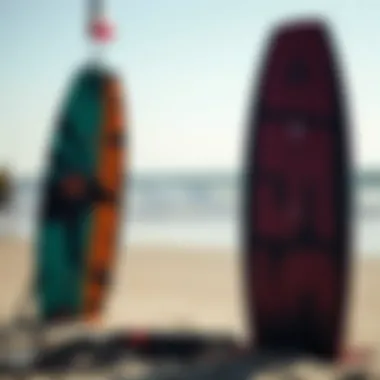

Directional boards are tailored for performance in waves and are built specifically to ride in one direction. These boards excel in providing stability and control, particularly when riding downwind. The unique shape allows for a more cohesive experience with the kite, enhancing your ability to link turns and navigate the water's surface smoothly. Often, riders appreciate the feeling of being connected to the wave, as these boards allow for fluid movement.
Benefits of Directional Boards:
- Stability: Built to handle various water conditions, they provide exceptional stability that helps in navigating through rougher waters.
- Control: The design aids in tracking straight, giving riders confidence as they take on bigger waves.
- Surfing Capability: They perform well in surf, making them a go-to for those who enjoy blending kiteboarding with surfing.
While the directional board may not be the top pick for every situation, it shines in wave riding scenarios where its features can truly be appreciated.
Twin-Tip Boards
Twin-tip boards, as the name suggests, have a symmetrical shape that allows for riding in either direction. This feature is paramount for beginners, as it provides a forgiving platform for learning and experimenting with different moves. With its versatile nature, twin-tip boards can handle jumps, tricks, and even unhooked maneuvers quite effectively.
Advantages of Twin-Tip Boards:
- Versatility: Ideal for new riders and those who enjoy freestyle moves. They can tackle a myriad of conditions, making them a top choice for many.
- Ease of Use: Riders don’t have to worry about stance while riding; they can switch easily between regular and goofy footed positions.
- Trick-Friendly: The balance and stability make it easier to attempt and land tricks, offering a smooth ride for adventurous spirit.
This adaptability makes twin-tip boards a common selection among both novice and experienced riders who want to hone their skills without the limitations of directional designs.
Hybrid Boards
Hybrid boards merge the designs of both directional and twin-tip boards, providing a balanced experience for riders. They often feature a narrower outline with elongated tips that combine the stability of directional boards with the versatility of twin-tips. This design caters to a larger range of riding styles, allowing riders to tackle waves while still enjoying freestyle performance.
Key Features of Hybrid Boards:
- Performance Versatility: Whether you’re catching waves or hitting the park, hybrids allow for flexibility that suits various conditions.
- All-Rounder: They can be an excellent option for those who want to dabble in multiple aspects of kiteboarding without needing a quiver of boards.
- Progressive Ride: Their design can facilitate learning and progression, making it easier for riders to grow their skills over time.
Ultimately, hybrid boards can be appealing for kiters seeking a middle ground, merging aspects of control and versatility in one package.
When choosing your kiteboarding board, consider your skill level, riding style, and the environment where you'll be riding. The right board can elevate your kiteboarding experience to new heights.
Understanding the characteristics and benefits of each type of board ensures that you are equipped with knowledge pivotal for making an informed choice. Boards are more than just gear; they are an extension of your kiteboarding experience, a partner that ebbs and flows with your movements within the water.
Harnesses and Safety Gear
In the realm of kiteboarding, the importance of harnesses and safety gear cannot be overstated. These elements play a pivotal role not just in enhancing performance, but also in ensuring the safety and comfort of the rider. High winds and turbulent waters present an ever-present risk, making it crucial to have proper equipment that allows you to maintain control and protect yourself while enjoying the thrill of the ride.
Harnesses serve as the direct link between the kite and the rider. They support the weight and allow for a more relaxed grip on the lines, which in turn minimizes fatigue during longer sessions. Equally, safety gear, including impact vests and helmets, act as protective shields against the unexpected. Well-chosen harnesses combined with the right safety gear facilitate a seamless and enjoyable experience on the water, safeguarding riders against potential harm while maximizing their ability to perform.
Different Types of Harnesses
Waist Harness
The waist harness is perhaps the most popular choice among seasoned kiteboarders. This type of harness sits at the waist, allowing for a greater range of movement compared to others. One key characteristic of a waist harness is its ability to distribute pressure evenly across the body. Riders often find it more comfortable, especially during extended sessions. A unique feature of this harness is its low-profile design, ensuring minimal interference with the rider's movements. While it’s favored for its agility, some may struggle with lower back support, especially when tackling strong winds or engaging in more aggressive maneuvers. However, many find that this minor trade-off is worth the enhanced freedom it provides.
Seat Harness
On the other hand, the seat harness offers a different kind of support. Typically, it wraps around the hips and extends down the thighs, providing a snug fit that some riders swear by. One advantage of this type of harness is its superb stability, which can be especially beneficial for beginners still mastering the nuances of balance and technique. It keeps the rider securely in place, reducing the risk of slipping during sudden jerks or heavy gusts. However, while it excels in stability, the added material can restrict some movements. This could be a drawback for those who value speed and agility.
Leg Straps
Leg straps are an often-overlooked part of the harness system but play an essential role in overall kiteboarding safety and efficacy. These straps secure the harness in place, enhancing the connection between the kite and the rider. Their key characteristic is the way they help maintain optimal positioning, ensuring that the harness does not ride up or shift unexpectedly. For many, leg straps create an added sense of security during maneuvers, especially in challenging conditions. However, improper adjustment or fitting can lead to discomfort, which might distract a rider from focusing on their technique and the environment around them.
Safety Equipment
Impact Vests
Safety gear, such as impact vests, provides an extra layer of protection for kiteboarders. These vests are designed to cushion the impact from falls or crashes by absorbing some of the shocks that come from hitting the water or other surfaces. One significant characteristic of impact vests is their lightweight design, which doesn’t compromise mobility. This makes them especially appealing to those who want to maintain agility while still having the assurance of added safety. However, while these vests can protect against impact, they may not provide adequate thermal insulation for colder waters unless a thicker model is chosen.
Helmets
Wearing a helmet is becoming increasingly common among kiteboarders for good reason. A helmet serves as the first line of defense against head injuries sustained during falls, collisions, or unexpected impacts from the board or the kite itself. The key characteristic of helmets is their ability to reduce the risk of serious injuries, providing peace of mind while cruising at high speeds or performing tricks. Yet, some riders find that helmets can be uncomfortable or may limit visibility. Finding a well-fitted helmet that balances safety and comfort is crucial to ensure it meets a rider's needs.
Safety Leashes
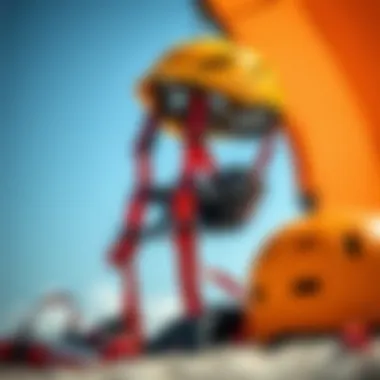

Lastly, the safety leash is an indispensable piece of kiteboarding gear. The primary role of the safety leash is to keep the kite connected to the rider in case of a fall, preventing the kite from becoming a runaway danger. The unique feature of safety leashes is their quick release mechanism, which allows the rider to detach rapidly from the kite when necessary. This capability can be a game changer in life-threatening situations. While safety leashes are undoubtedly crucial, improper use or malfunction can lead to significant hazards, making it vital for riders to regularly check their gear for wear and tear.
In kiteboarding, staying safe is about more than just wearing gear; it's about choosing the right gear that fits your style and conditions.
Through a profound understanding of harnesses and safety gear, kiteboarders can enhance their performance while ensuring proper safety measures are in place. Choosing the appropriate equipment can make the difference between an exhilarating experience on the water and one filled with preventable risks. When investing in gear, prioritize comfort, fit, and protection – your future adventures depend on it.
Choosing the Right Gear
Selecting the appropriate kite gear is fundamentally crucial for both the novice and seasoned kiteboarder. Just as one cannot expect to conquer the waves with an inadequate board or poorly-suited kite, the quest for the right equipment has a significant impact on performance, safety, and overall enjoyment. With a vast array of options available, understanding how to choose wisely expands the boundaries of the kiteboarding experience—enabling enthusiasts to push limits and paddle through thrilling adventures. Factors such as skill level, local conditions, and personal preferences play a pivotal role in guiding this essential process.
Assessing Your Skill Level
The first step in this journey is a clear-eyed assessment of your skill level. Beginner kiteboarders should pay attention to different types of kites and boards, as they can vary greatly in ease of use and safety. These early days on the board often demand equipment that is forgiving and simple to handle. Typically, larger kites are favored due to their stability and ability to generate lift even in lighter winds.
- Beginners might benefit from inflatable kites that offer added safety features, like relaunch capabilities.
- Intermediate and advanced riders should contemplate performance-oriented gear, prioritizing speed and maneuverability in their choice of kites and boards.
It's vital to consider personal growth, too. A kite that suits a beginner might not adequately support after some experience, so it is wise to seek equipment that will grow alongside your skillset. This ensures you can continue to progress without being held back by your gear. Taking lessons from experienced instructors can also provide invaluable feedback on gear selection, ensuring you obtain items that facilitate rather than hinder your development.
Understanding Your Local Conditions
What works in one locale might be a poor choice in another, which underscores the importance of knowing your local conditions. Understanding wind patterns, water types, and terrain can dramatically alter your gear needs. Here’s how to break down important conditions:
- Wind Strength: Light winds might call for larger kites, while stronger winds necessitate smaller kites with less surface area.
- Water State: Flat water is generally more accommodating for beginners who want to practice tricks, suggesting a need for gear that enhances stability and control. Conversely, choppy waters or waves require more robust gear that can handle instability.
- Location and Terrain: Riding in the ocean poses different challenges compared to lakes or rivers. Saltwater can affect equipment differently than fresh water, so choosing durable materials can enhance longevity.
Getting a grasp on these environmental elements not only aids in gear selection but can also create a more enjoyable and safe kiteboarding experience. Take time to study local conditions, consult with fellow kiters, and engage with online communities in forums like Reddit or specialized Facebook groups for insights.
"A well-informed kiteboarder is a successful kiteboarder."
By grasping your skill level and local conditions, you position yourself for success. Knowledge translates into smart gear choices that meet your specific needs, guaranteeing each session on the water is not just safe but also exhilarating. This combination of savvy decision-making will surely make kiteboarding a more enjoyable pursuit, filled with opportunities for growth and adventure.
For further resources on kiteboarding, you can explore more at Wikipedia on Kiteboarding or engage with other kiteboarding enthusiasts through Facebook Groups.
Finding Gear for Sale
When it comes to kiteboarding, finding the right gear is crucial. The equipment you choose can make or break your experience on the water. Whether you're a novice looking to buy your first kite or a seasoned pro searching for the latest innovations, understanding where to find quality kite gear is essential. This section delves into the main avenues for acquiring equipment—online retailers, local shops, and second-hand options. Each marketplace comes with its benefits and considerations that can influence your purchasing decision.
Online Retailers
The convenience of online shopping can’t be overstated. With just a few clicks, every kiteboarder can access an endless array of products. Online retailers like Kiteboarding.com and Amazon often feature extensive selections, exclusive deals, and customer reviews. Here’s what sets them apart:
- Wide Selection: Browse through a multitude of brands, models, and prices without leaving your home.
- Customer Reviews: Read feedback from other kiteboarding enthusiasts to gauge performance and durability.
- Comparative Shopping: Easily compare prices across different websites to find the best deal.
However, it’s important to consider shipping costs and return policies. Sometimes, delivery can take longer than expected, and returning large items may be a hassle. Double-check sizing charts and product specifics to avoid disappointment.
Local Shops
For those who prefer a hands-on approach, local shops offer a unique experience. Visiting a store allows you to interact directly with knowledgeable staff who can guide you based on your specific needs. Places like The Kite Shop or Kite Elements present several advantages:
- Expert Advice: Talk to staff about what gear suits your skill level and local conditions.
- Try Before You Buy: Some shops offer demo gear, allowing you to test it out on the water.
- Building Community: Engaging with local kiteboarders can foster a closer-knit community, ideal for sharing tips and tricks.
On the flip side, local shops may have more limited stock than online retailers. Prices might also vary, so it pays to do some research beforehand to ensure you're getting a competitive deal.
Second-Hand Options
For budget-conscious kiteboarders, second-hand gear can be a treasure trove. Websites like Kijiji or local Facebook groups often have listings where you can snag quality equipment at a fraction of the original cost. Here are a few points to keep in mind:
- Cost-Efficiency: Great way to build up your gear collection without breaking the bank.
- Hidden Gems: Sometimes you can find barely-used equipment that's just looking for a new home.
- Bargaining Power: Sellers are often willing to negotiate prices, making it a potentially lucrative deal.
While hunting for second-hand gear, be cautious. Always check the condition thoroughly and, if possible, meet in person to inspect the gear. Pay attention to any signs of wear and tear that could affect your performance or safety.
In summary, finding kite gear for sale can be an enriching journey. Whether you opt for the convenience of online shopping, the expertise of local shops, or the budget-friendly second-hand market, each avenue has its unique offerings that can cater to your gear needs.
Emerging Trends in Kite Gear
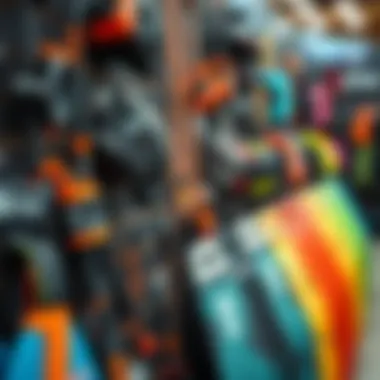

The kiteboarding landscape is changing at a rapid pace as enthusiasts and designers alike adapt to advancements in technology and shifting consumer preferences. Understanding these emerging trends is essential for anyone looking to navigate the world of kite gear effectively. New materials, innovative designs, and a growing focus on sustainability are transforming how we interact with kiteboarding equipment. Recognizing these trends can empower kiteboarders to make informed decisions that enhance their experience on the water and contribute positively to the environment.
Innovations in Materials
In recent years, there has been a notable shift towards high-performance materials in the kite gear industry. Traditional fabrics are being swapped out for lighter, stronger alternatives. For instance, manufacturers are now using ripstop nylon and polyester that boast enhanced durability while maintaining lightweight characteristics. These materials not only stand up to the rigors of kiteboarding but also allow for better performance in various wind conditions.
Moreover, customized hardware is gaining traction. Kites are fitted with hybrid materials that mix plastics and metals, promising more efficient energy transfers and control. Innovators are often experimenting with smart fabrics that react to wind conditions, ensuring the kite performs optimally.
The benefits of these innovations are clear: kiteboarders enjoy better control, improved maneuverability, and enhanced longevity of their gear. As competition heats up among manufacturers, consumers can expect an influx of products that push the boundaries of performance.
Sustainability in Kiteboarding Equipment
Sustainability is no longer just a buzzword; it’s swiftly becoming a cornerstone of the kiteboarding industry. A growing number of companies are actively integrating eco-friendly practices into their manufacturing processes. For instance, some brands are now using recycled materials to produce their kites and boards. This not only lessens the environmental impact but also meets the demands of environmentally-conscious consumers.
Furthermore, there's a shift in packaging methods as well. Many companies are reducing plastic usage in their packaging, instead opting for biodegradable or reusable materials. As a result, customers can be assured that their purchase does not contribute to landfill waste.
A key consideration for kiteboarders, outdoor enthusiasts, and even instructors is the long-term impact of their gear choices. Investing in sustainable equipment is not only beneficial for the environment but also sets a precedent in the sport for future generations. By choosing gear with sustainable practices, kiteboarders can ride the waves with a clear conscience, knowing they are partaking in a movement that aims to protect the natural world.
The future of kiteboarding equipment lies in the hands of responsible brands that prioritize sustainability. Choosing environmentally-friendly gear can amplify your kiteboarding experience, allowing you to enjoy the sport while being conscientious about your impact on the planet.
As kiteboarders evolve, so too will the materials, designs, and approaches in kite gear. To stay ahead of the game, keeping an eye on these emerging trends helps ensure that any choice made today has lasting benefits for both performance and the environment.
Caring for Your Kite Gear
Caring for your kite gear is as crucial as picking the right equipment in the first place. Just like a car, your kite gear needs regular attention to keep it performing smoothly. Without proper care, what was once a thrill might turn into an ordeal. Thankfully, proper maintenance can prolong the lifespan of your equipment, saving you money and hassle down the road. You don’t want to be the person struggling with a fraying line or a malfunctioning kite out on the water.
Making it part of your routine isn’t just about preservation; it’s about ensuring safety and performance. Faulty gear can lead to accidents that could be easily avoided with a little extra effort in maintenance. In short, it pays dividends both in terms of enjoyment and safety.
Maintenance Tips
To keep your kite gear in top shape, consider these essential maintenance tips:
- Regular Inspections: Before and after every session, check your kite for signs of wear. Look for nicks, tears, or any unusual signs. This habit might take a few minutes but it can save a lot of trouble.
- Cleaning: Sand and salt can be detrimental to your gear. Rinse everything with fresh water after each use. It’s simple but effective.
- Drying: After cleaning, dry your gear completely before storing it. Leaving it damp can lead to mildew, which is not only unpleasant but can also deteriorate fabrics.
- Repairs: If you spot an issue, don’t delay repairs. Use kite repair tape for small tears or consult a professional for more significant damages. Many shops offer repairs, so you don’t have to toss out expensive items.
Adopting these simple maintenance habits can extend the life of your equipment significantly.
Storage Best Practices
Just as important as daily maintenance is how you store your gear. Proper storage will protect your equipment from damage and wear when not in use. Here are a few guidelines:
- Cool, Dry Place: Keep your gear away from extreme temperatures and moist environments. A closet or a spare room can work wonders. It’s best to avoid garages or basements that may be prone to humidity.
- Avoid Sunlight: Prolonged exposure to UV rays can degrade the materials. Ensure that kites are stored in bags or cases that protect them from light.
- Organized Setup: Arrange your equipment to avoid unnecessary pressure. Storing kites in a relaxed condition— not tightly packed— helps maintain their form and function.
"Your gear is an extension of you. Treat it well, and it will respond in kind."
For more information on proper care techniques, you may also check out resources from leading manufacturers or check forums like reddit.com/r/kiteboarding for community tips and advice.
Culmination
As we draw the curtains on our extensive look into kite gear, it’s vital to understand the significance of choosing the right equipment. The right kite gear acquisition isn't just about aesthetics or brand names. It’s about enhancing the overall kiteboarding experience, ensuring safety, and improving performance. Without a well-thought-out purchase, even seasoned enthusiasts might find themselves in less-than-ideal situations, risking their passion for this exhilarating sport. Considerations such as durability, functionality, and suitability to your personal style of riding play a crucial role in making decisions. The quality of gear can significantly influence not just your ability to maneuver but also your enjoyment of the sport.
Final Thoughts on Kite Gear Acquisition
When you set out to acquire kite gear, it’s akin to selecting the right brush for a canvas. Every piece has its role, whether that’s the stability and lift of your kite or the responsiveness of your board. Each item acts harmoniously to elevate your performance. For instance, investing in a well-constructed harness can mean the difference between a gnarly ride and smooth sailing.
Be sure to consider various factors:
- Your skill level: Newcomers may not need high-end gear as professionals do.
- Local conditions: The wind patterns and water conditions at your typical spots can dictate the type of kite or board to choose.
- Long-term needs: Think about how your skills will grow over time. This forward-looking view can save money in the long run.
Are you ready to take the leap to explore reputable brands and shops that resonate with what you desire?
Encouragement to Explore and Choose Wisely
Exploration is key in the realm of kite gear. Don’t merely settle for the first gear you come across. Delve deeper into reviews, participate in forums, or consult fellow kiteboarders about their experiences. Websites like reddit.com can be treasure troves of information where enthusiasts share their first-hand experiences.
When it comes time to make purchases, explore avenues: online retailers can offer transparency with customer feedback, while local shops can provide hands-on experience with gear.
Additionally, don’t shy away from second-hand options. Many skimp on gear simply because they fear the hefty price tags but finding quality gear from previous owners can lead to significant savings without sacrificing quality. Websites and platforms like facebook.com, or local marketplace groups might help you find a diamond in the rough.
Wrapping up, the journey of selecting kite gear tailored for your adventures is just as thrilling as the sport itself. Arming yourself with knowledge, being patient, and making informed choices will undoubtedly lead to fulfilling experiences on the water. Let's make those aerial tricks and smooth glides a reality with the gear that serves you best.











